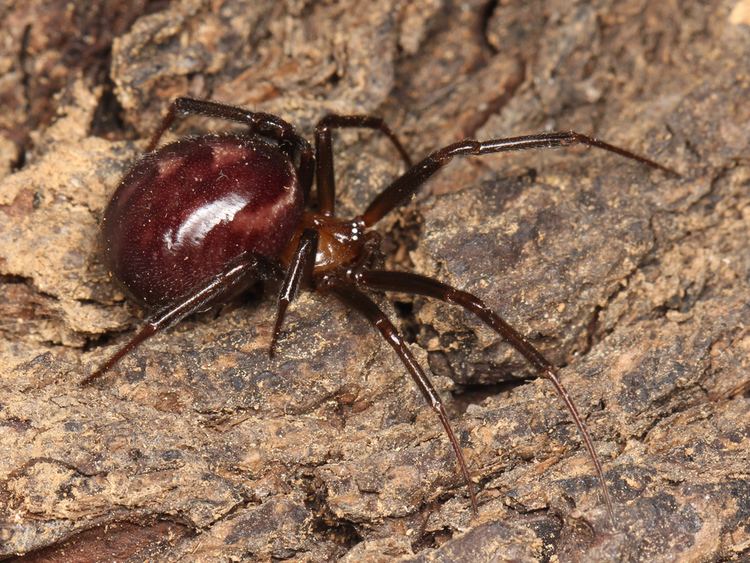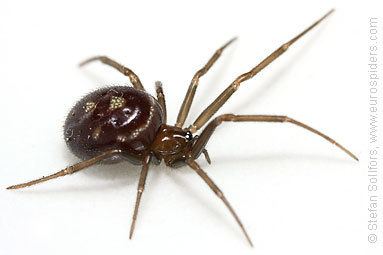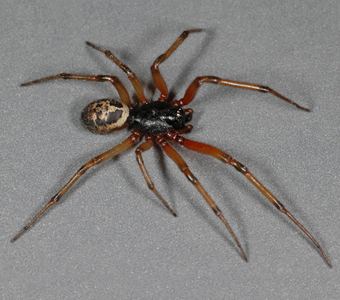Order Araneae Scientific name Steatoda Rank Genus | ||
 | ||
Lower classifications Steatoda grossa, Triangulate cobweb spider, Steatoda bipunctata, Steatoda paykulliana | ||
Feeding a false widow spider steatoda grossa in hd 1080p
The spider genus Steatoda, in the family Theridiidae, includes over 120 recognized species, distributed around the world (including many cosmopolitan species which are found among human populations worldwide). One common name is Cupboard Spider, many species building their webs in dark, sheltered, undisturbed places around the house or garden, in sheds and garages, under garden furniture, compost bins, and the like. Signs of the Cupboard Spider include small white spots of spider droppings, like small splashes of paint, on the floor underneath the web.
Contents
- Feeding a false widow spider steatoda grossa in hd 1080p
- Steatoda nobilis false widow spider
- Diet
- Species
- Other notable and recognizable species
- References

They have a small cephalothorax and a larger abdomen, which is somewhat egg-shaped. The colour can range from a brown or reddish plum to satiny black. The abdomen often has white or beige spots, a frontal crescent, and sometimes, small red spots or a thin red line (but never a stripe like a Redback Spider).

Many spiders of the genus Steatoda are often mistaken for widow spiders (Latrodectus) and are known as false black widows. They are closely related (in the family Theridiidae) but Steatoda are significantly less harmful to humans. Not all Steatoda species resemble widows – many have distinct coloring, and are significantly smaller than Latrodectus specimens. Some species of Steatoda will actually prey on widows, as well as other spiders which are considered hazardous to humans.

Some members of this genus do have bites which are medically significant in humans (such as S. grossa and S. nobilis), however bites by Steatoda species generally do not have any long-lasting effects. There may be blistering at the site of the bite and a general malaise lasting for several days. Symptoms can include moderate to severe pain increasing for the first hour (without severe sweating). Some people have reported mild to moderate nausea, headache, and lethargy. The duration of all symptoms and effects can range from 1 to 60 hours.

The symptoms associated with the bite of several Steatoda species are known in the medical profession as steatodism; and have been described as a less-severe form of latrodectism (the symptoms associated with a widow spider bite). The redback spider antivenom has been thought to be effective at treating bites from S. grossa, after it was mistakenly administered to a S. grossa bite victim who was erroneously believed to have been bitten by the far more dangerous redback. (While the redback antivenom appears clinically active against arachnidism caused by Steatoda spiders;[68][100][101][102], as these cases are often mild and the evidence of its effectiveness is limited, this treatment is not recommended.)[90]

In common with other members of the Theridiidae family, the Steatoda spiders construct a tangled web, i.e., an irregular tangle of sticky silken fibers. As with other web-weavers, these spiders have very poor eyesight and depend mostly on vibrations reaching them through their webs to orient themselves to prey or to warn them of larger animals that could injure or kill them. They are not aggressive, and most injuries to humans are due to defensive bites delivered when a spider gets unintentionally squeezed or pinched somehow. It is possible that some bites may result when a spider mistakes a finger thrust into its web for its normal prey, but ordinarily intrusion by any large creature will cause these spiders to flee.

Steatoda nobilis false widow spider
Diet
Steatoda is known to prey on other spiders (including true black widows), crickets, cockroaches, and woodlice.
Species
There are currently over 120 recognized species in Steatoda.
Those commonly mistaken for widows include:

Other notable and recognizable species
Other notable and recognizable species in the genus include:

